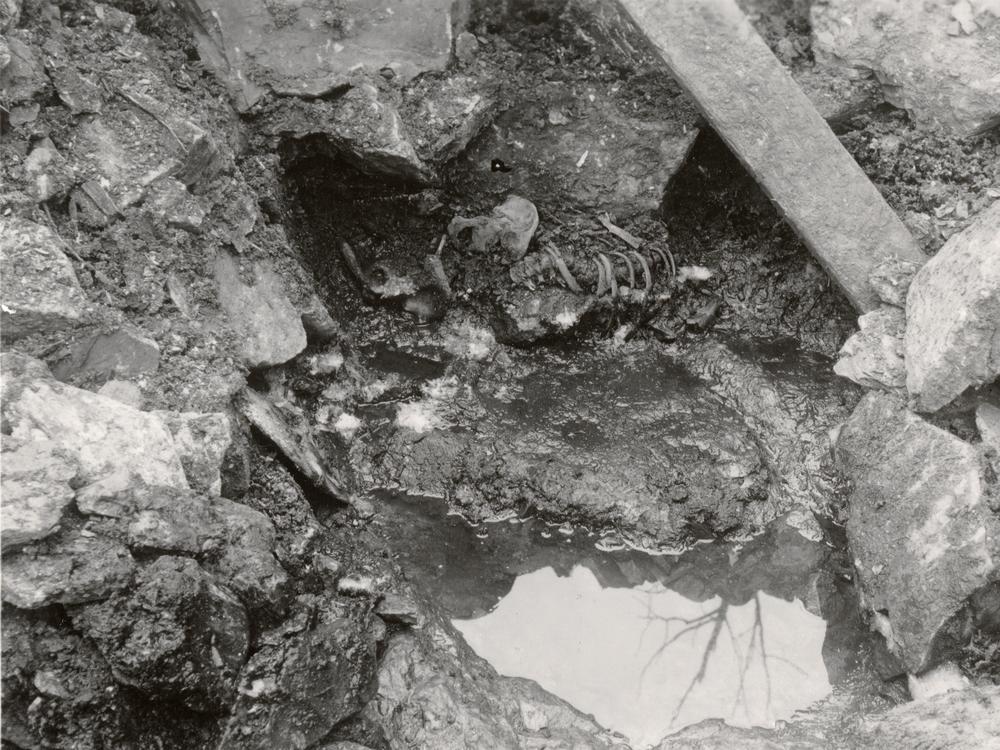Section Branding
Header Content
Centuries-old remains found in a well may be man from Norse saga
Primary Content
In the 12th and 13th centuries, Norway was racked by civil war. It’s a period chronicled in an ancient Norse text called the Sverris Saga, which is named after king Sverre Sigurdsson.
The saga tells of the king’s ongoing feud with his chief enemy, the archbishop.
“He ordered one of his closest associates to write his story to have a record of everything that happened in his life, “so the Sverris Saga has a strong bias to King Sverre," says Anna Petersen, an archaeologist with the Norwegian Institute for Cultural Heritage Research.
“Battles are described in detail,” she says, including one that took place around the year 1180 near the present-day city of Trondheim, in central Norway. The archbishop’s fighters attacked the king’s castle when the king was away.
“They let everyone go,” she says. “They saved their lives. But they completely destroyed the castle. They burned all the houses.”
Then, Petersen says, “the archbishop’s people wanted to do something nasty.”
The saga reads: “They took a dead man and cast him into the well headfirst, and then filled it up with stones.” Petersén says most scholars have assumed he was connected to the king.
Perhaps they wanted to poison the water supply or humiliate the king and his men.
Either way, the text adds “nothing about who this dead man was, where he came from, what group he belonged to,” says Petersen.
Now, in a study published in the journal iScience, Petersen and her colleagues describe sequencing the genome of a sample of 800-year-old DNA that may well be the man thrown down that well centuries ago. The research offers a glimpse into where he came from and what he may have looked like before he met his tragic end.
Down the well and into the lab
In 1938, a partial excavation of the well some 21 feet deep revealed a man’s skeleton — possibly that of the person described in the saga. The remains were left in place.
Then, a decade or so ago, Petersen and her colleagues started the hard work of lifting out the uneven and slippery stones — along with a lot of rubbish — and uncovered the skeleton.
“He had a bad back and he has evidence of heavy manual labor all his life,” she says. “So he was a tired man already before his death.”
Petersen knew there must be more to the story, so she teamed up with evolutionary genomicist Michael Martin from the Norwegian University of Science and Technology.
“We managed to take a sample from two different bones from the skeletal remains,” he says. “From the cranium and the leg bone.”
Martin and one of his students, Vanessa Bieker, donned double gloves, hairnets, and booties, and entered the lab to collect as much DNA as possible from those old bones. “It’s not a very comfortable working environment,” he says.
“We’re very frustrated to find that it was almost entirely bacterial DNA,” says Martin. There’s been a lot of degradation of the original human DNA.”
Then, another student, Martin Ellegaard, had the idea to look for more skeletal material.
“Once he got a hold of the teeth,” Martin recalls, “then things really changed.”
The root of one of those teeth had enough DNA that the researchers could sequence the man’s genome and compare it to people today, including thousands of Norwegians.
“We were able to deduce that he was a male,” says Martin. “We could say that he was very likely to have blue eyes, blonde hair and an intermediate skin tone and that his ancestry traces back to a very specific county in southern Norway.” This last piece of information suggested that people moved around in Medieval times.
A side character takes center stage
Martin says the findings add new detail to the centuries-old story. “Just finding the remains shows [these stories are] not made up,” he says. “They might be elaborated and exaggerated, but they’re based on fact.”
The researchers say this is the oldest genome to be sequenced of a specific person from an old text. Was he a king’s man, though?
Dana Kristjansson, a genetic epidemiologist at the Norwegian Institute of Public Health who wasn’t involved in the study, agrees the results support the story of the man pitched down the well, but it’s circumstantial.
“We can’t prove that this person is actually that which was described,” she says. “Some of the stories tend to be more accurate than others, even if they involve real people and events.”
Still, this skeleton did belong to someone who lived at the time documented by the Sverris Saga, and these new details about his appearance and origins that are inscribed in his DNA personalize him.
“He has been no one, says Petersen. “But now he has become someone. He has had a life.”

